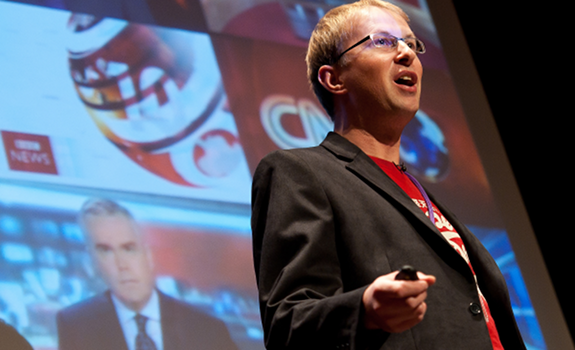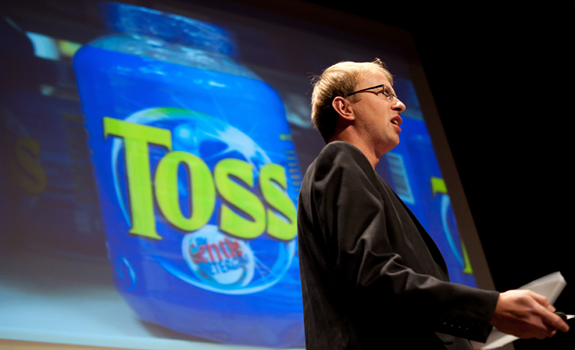If you’re a radio producer, you need to break old boundaries to set new standards and keep radio alive. What holds you back? And how do you get out of your comfort zone?
Radio production expert Steve Martin talked about 5 creative perils to avoid (and what to do instead) during a fun session at nextrad.io in London last week. Bottom line: creative radio people should not be afraid and dare to try something different. “It’s sometimes easier to ask for forgiveness than it is to ask for permission.” { Includes audio }
5. Formula
Rewrite the format rules
Consistent radio needs tight formats, but sometimes you need to redefine them to keep radio interesting. Steve Martin: “If you want to be a creative leader, it’s sometimes right to subvert formula.” He shows that the color of TV news was blue for many years, until designer Martin Lambie-Nairn and the BBC turned it all around. They replaced the color of authority by red, the color of excitement. “Revolutionary and a bit scary” things take people out of their comfort zone, and start a trend. Because since then, TV news backgrounds worldwide have been based on… red. A good example of rewriting the format rules.

Steve Martin: “If you want to be a creative leader, it’s sometimes right to subvert formula” (photo: Dan Smyth)
4. Irrelevance
Choose the right moment
Sometimes messages are poorly targeted or broadcast at the wrong time: “I was enjoying Capital FM’s dance tunes on Saturday night, until the British Gas ad came on with the immortal line: Now is the time to think about changing your boiler. No, it is not – it’s Saturday night!” According to Martin, beating irrelevance is more than good media planning. It’s also good timing. Even a weird promo that pops up totally unexpected can be effective, if it’s relevant for the target audience at that day and time. “When you have a great idea, don’t send it on an irrelevant mission. Bank it for when it’s going to be the most powerful and relevant.”
 3. Vanity
3. Vanity
Focus on helping people
Vanity is not just about “clients who want to voice their own ad”, it’s also about radio producers who write promo copy and don’t ask themselves how it helps the audience. Mentioning that a company is in business for an x amount of years doesn’t necessarily get people to buy their stuff. Effective radio spots don’t brag, but focus on benefits for the listener instead.
2. Claims
Respect your audience’s intelligence
Unsubstantiated and subjective claims are seen and heard a lot in advertising. Like the Russian Tea Room in New York which is The world’s most famous restaurant (but not according to Google). Needless to say: this won’t work. “Consumers can spot toss a mile off now, and it’s a distraction from the sales message.” Bad claims can also be heard in (vintage) radio jingles, like: We’re with you through to midnight, we are your best friend… Radio Lincolnshire. Steve Martin: “No, you’re not my best friend. And it’s creepy.”

Steve Martin: “Consumers can spot toss a mile off, and it’s a distraction from the sales message” (photo: Dan Smyth)
1. Fear
Do it & ask forgiveness
Most of all, radio people should not be afraid to fail, or to upset people. One of the ways to defend your creativity is to avoid that many people sign off your ideas. “Somebody somewhere will hate your work. The more people you ask, the more likely you are to find them”, Steve Martin says. Just in case it happens, you should always have a plan B. “And if you work for, let’s say, a Big Broadcasting Corporation, you find out that it’s sometimes easier to ask for forgiveness than it is to ask for permission.” He plays a few examples of creative productions as “a tribute to the producer’s belief and their manager’s guts”.
Creative radio production examples
[audio:http://www.radioiloveit.com/wp-content/uploads/steve-martin-presentation-creative-radio-productions-nextradio-london-2011.mp3|titles=steve-martin-presentation-creative-radio-productions-nextradio-london-2011.mp3]
 About
About
Steve Martin has a background in journalism, marketing and production – such as radio promotion copywriting and station sound design. He launched the BBC Cross Trail department and updated the BBC World Service on-air sound. Now he works with African radio stations on behalf of the British public broadcaster. Steve also blogs, tweets and podcasts about ‘great radio production and the people who make it’ on his platform Earshot Creative Review.





Add Your Comment